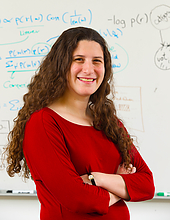 A computational linguist in the University of Maryland Institute for Advanced Computer Studies (UMIACS) plans to use machine teaching algorithms to predict which language interventions are most effective for helping children with developmental language disorders.
A computational linguist in the University of Maryland Institute for Advanced Computer Studies (UMIACS) plans to use machine teaching algorithms to predict which language interventions are most effective for helping children with developmental language disorders.
Naomi Feldman, an associate professor of linguistics with an appointment in UMIACS, was just awarded $435K from the National Institutes of Health (NIH) for a two-year pilot program to address specific language impairment (SLI), which delays the mastery of language skills in children who have no hearing loss or other developmental delays.
According to the National Institute on Deafness and Other Communication Disorders, SLI is one of the most common childhood learning disabilities, affecting approximately 7 to 8 percent of children in kindergarten.
Feldman, who is also part of the university’s Language Science Center, will collaborate on the project with Pat Shafto, an associate professor of mathematics and computer science at Rutgers University-Newark, and Jan Edwards, a professor in the Department of Hearing and Speech Sciences at UMD.
“This research is important because the only way to help children who have language disorders is to modify the language they hear, that is, their linguistic input,” Feldman says. “If we can develop a theoretical framework for predicting which input is most effective, this can ultimately lead to more effective treatments for language disorders.”
Feldman says the team will be using datasets provided by Elena Plante, a researcher who conducts interventions with children who have SLI, to create models of learning that are designed to mimic the deficits of children with SLI. They will also use ideas from machine teaching to predict the specific children’s learning outcomes in the interventions.
For example, the researchers could utilize the models to predict which sets of verbs would be best to use for teaching children how to use the “-ed” past tense, and then compare their predictions with the actual outcomes of children who heard different sets of verbs during their intervention.
Similar approaches are also potentially applicable in other language learning situations, such as second language acquisition, Feldman says, adding that the research team will make extensive use of UMIACS' computational resources for their simulations to implement models of learners and teachers.
—Story by Melissa Brachfeld